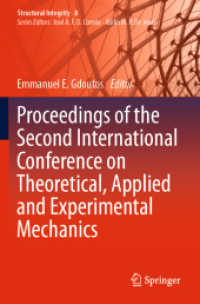- ホーム
- > 洋書
- > 英文書
- > Literary Criticism
Full Description
Arguing that vision was the dominant mode for understanding suffering in the Romantic era, Elizabeth A. Dolan shows that Mary Wollstonecraft, Charlotte Smith, and Mary Shelley experimented with aesthetic and scientific visual methods in order to expose the social structures underlying suffering. Dolan's exploration of illness, healing, and social justice in the writings of these three authors depends on two major questions: How do women writers' innovations in literary form make visible previously unseen suffering? And, how do women authors portray embodied vision to claim literary authority? Dolan's research encompasses a wide range of primary sources in science and medicine, including nosology, health travel, botany, and ophthalmology, allowing her to map the resonances and disjunctions between medical theory and literature. This in turn points towards a revisioning of enduring themes in Romanticism such as the figure of the Romantic poet, the relationship between the mind and nature, sensibility and sympathy, solitude and sociability, landscape aesthetics, the reform novel, and Romantic-era science. Dolan's book is distinguished by its deep engagement with several disciplines and genres, making it a key text for understanding Romanticism, the history of medicine, and the position of the woman writer during the period.
Contents
Contents: Introduction; Part 1 Illness: Melancholia and the poetics of visibility: Charlotte Smith's Elegaic Sonnets; Contagion, sympathy, invisibility: Mary Shelley's Frankenstein. Part 2 Healing: The journey to heal melancholia: Mary Wollstonecraft's Letters fron Norway; Scientific botany as therapy: Charlotte Smith's literature; Invisibility and the history of trauma: Mary Shelley's Rambles in Germany and Italy. Part 3 Social Justice: Seeing poverty: Smith's Rural Walks and Wollstonecraft's Original Stories as fictional ethnography; Unsentimental seeing: Wollstonecraft's The Wrongs of Woman and didactic children's literature; Afterword; Bibliography; Index.






